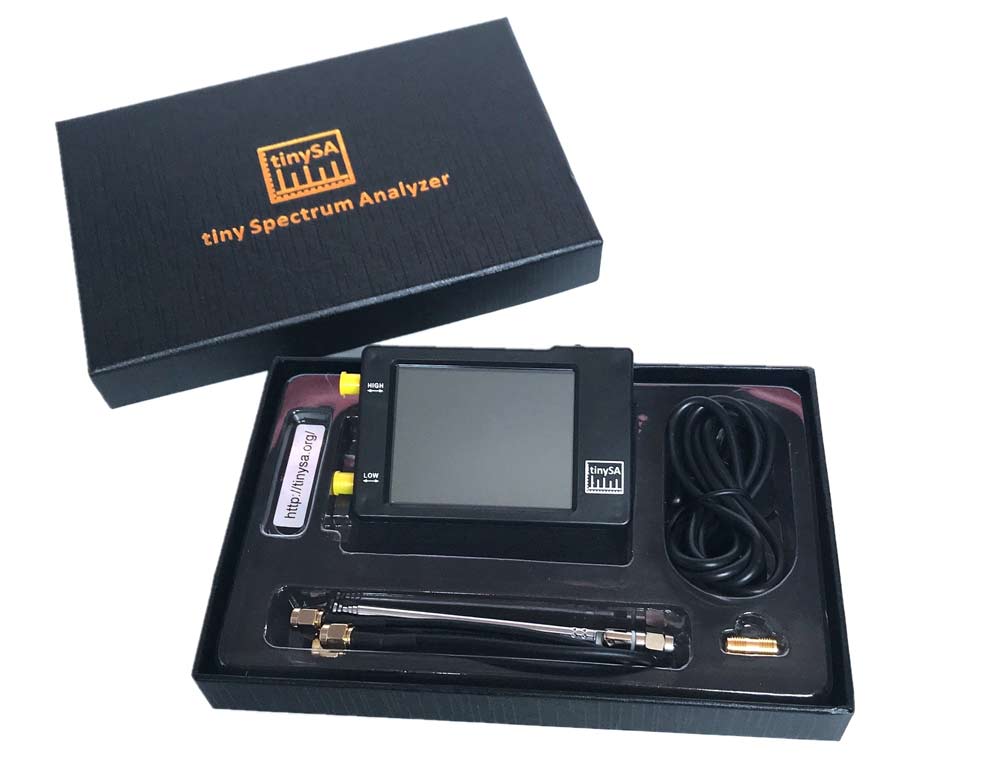The $49 tinySA Spectrum Analyzer
Thank you to a few readers for suggesting a post about the "tinySA". The tinySA is a low cost standalone spectrum analyzer which was made recently available from Chinese manufacturer "Hugen" who was the manufacturer that popularized the original NanoVNA. It can be found on Aliexpress for about $49 shipped worldwide. R&L also have US based stock available. The official specs from tinysa.org/wiki read:
- Spectrum Analyzer with two inputs, high quality MF/HF/VHF input for 0.1MHZ-350MHz, lesser quality UHF input for 240MHz-960MHz.
- Switchable resolution bandpass filters for both ranges between 2.6kHz and 640kHz
- Color display showing 290 scan points covering up to the full low or high frequency range.
- Input Step attenuator from 0dB to 31dB for the MF/HF/VHF input.
- When not used as Spectrum Analyzer it can be used as Signal Generator, MF/HF/VHF sinus output between 0.1MHZ-350MHz, UHF square wave output between 240MHz-960MHz.
- A built-in calibration signal generator that is used for automatic self test and low input calibration.
- Connected to a PC via USB it becomes a PC controlled Spectrum Analyzer
- Rechargeable battery allowing a minimum of at least 2 hours portable use
A spectrum analyzer allows you to view a defined slice of the frequency spectrum on a graph. It does not allow for demodulation of signals. We note that SDRs like the RTL-SDR could be used as a spectrum analyzer too with software like QSpectrumAnalzyer and Spektrum, however the advantage of the tinySA is that it is a standalone package with it's own screen that can easily be used in the field. Unlike an SDR extra computing devices like a computer or smartphone are not required.
Over on YouTube IMSAI Guy has been uploading a few videos reviewing the tinySA. From his videos he found a few issues including a slow update rate, harmonics and high phase noise. However, later he finds that most of the harmonic issues disappear as long as the input signal level is kept below -30dBm. In some more recent videos he also finds a fault with the attenuator chip on one of his tinySA units and repairs it by replacing the chip.

I am not very found of IMSAT guy and many of the other self styled “experts” on U-tube, his different videos look good but many have glaring errors. There seems to be a fundamental lack of the real engineering and physics about many of the items he pretends he knows. I generally avoid his videos and rather look at instructions from Agilent, Tektronix or Rohde . There I at least know it is correct. Every major manufacturer has ample of information and videos…start there before you watch videos made by people who know just enough to be dangerous you might safe a few bucks ny not destroying your projects.There is a reason hobbyist videos are not used in any real teaching environment.
There are several technical errors and misunderstandings of how the TinySA works in the “IMSAI guy” videos. Those interested in the TinySA should watch the videos posted in the link above by Erik (the developer) in order to assess the performance and capabilities of this very useful product. I own one and find that it works well as a low cost spectrum analyzer and signal generator. Good value for the money.
An active user community with more than 500 members can be found here: https://groups.io/g/tinysa/messages
here: https://tinysa.org/wiki/pmwiki.php?n=Main.Videos
A large number of videos demonstrating all functions (including their limitations) and various applications can be found